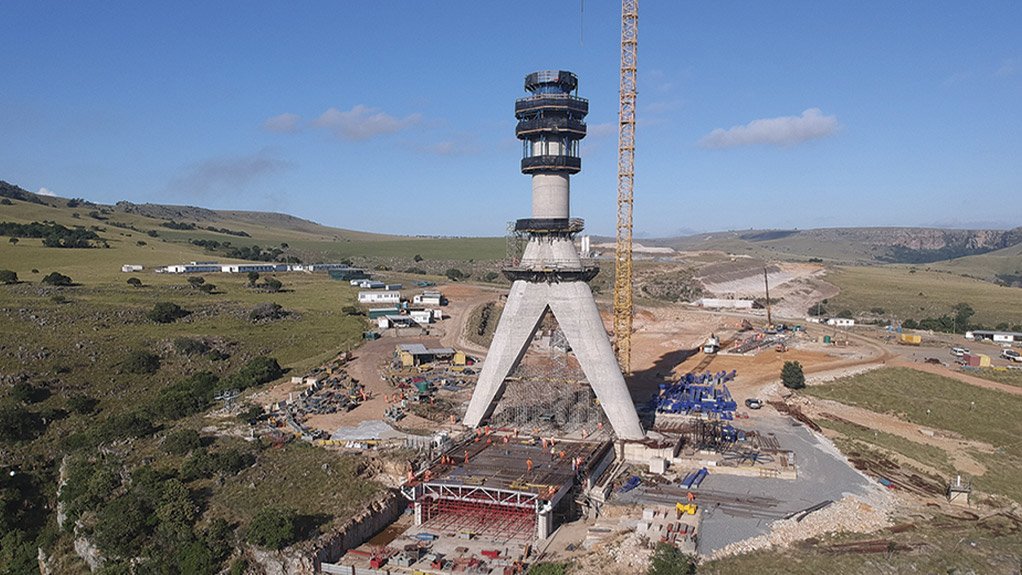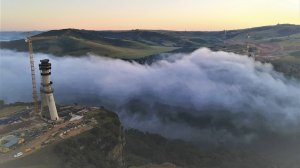Spires shoot skyward as Msikaba Bridge advances



With construction of the pylon spires underway at the Msikaba Bridge project, the scale of the development is quite apparent
Like the legs of the bridge pylon, the reinforced concrete spire is hollow to reduce weight and is formed in a tubular design improving its strength-to-weight ratio
This article has been supplied as a media statement and is not written by Creamer Media. It may be available only for a limited time on this website.
The pylon spires of South Africa’s Msikaba Bridge mega project are on their way up, soon to tower almost 130 metres high at each side of the near 200m deep river gorge.
For Laurence Savage, Concor’s Project Director on this contract, this momentous phase will reveal the sheer grace of the Msikaba Bridge design, and the awesome scale of the development. The Msikaba Bridge forms part of the South African National Roads Agency Limited’s (SANRAL) N2 Wild Coast project and is being constructed by the CME JV, a partnership between Concor and MECSA, both 100% black owned Grade 9CE South African construction companies.
Currently being slip-formed from the bifurcated legs of the pylons, each of the spires extend 95m from the bifurcation to the top of each pylon – taking the height of the bridge pylons to 128m.
“The inverted Y-shape of the concrete pylons is strikingly elegant, and will become a hallmark of this iconic structure – as the design is architecturally elegant, diverging from the foundation legs, up towards the bifurcation and symmetrically converging to the top of the spire,” says Savage. “This is the largest cable-stayed bridge to be built in South Africa, and probably one of the most complex engineering bridge projects yet executed in Africa.”
In this design, each pylon rests on two inclined legs which meet 21m from the start of the bifurcation which extends a full 11m. At 32m, the first section of the spire – starting with a diameter of six metres – is uninterrupted for 55,7m and comprises 14 slipform lifts. Then begins the inclusion of 17 anchor inserts over the next 35m of the spire, which reaches a height of 124m and will have converged to a four metre diameter. These anchor inserts accommodate the 17 cables that run from the anchor blocks located behind each pylon to the spire, and then down to the 580m long bridge deck.
“To accomplish the lifts, we are using a jacking system for the formwork shutters, with eight jacks around the circumference of the spire,” he explains. “Each lift is 3,6m conducted at intervals of about two weeks per lift and we are making steady progress with quality and safety being paramount.”
The work is accessed using a specialised stair system, with one set of access stairs from ground level to the top of the bifurcation and a second stairwell to follow the shutter system up the spire. The formwork system comprises three decks that trail below each other; the interlinked decks lift together as the shutters are jacked up.
“The depth of the gorge – at around 197m – means that no work on the bridge deck itself can be done from ground level,” he continues. “Everything has to be done suspended from these two pylons – one on the south side of the gorge and one on the north side of the river.”
Like the leg of the bridge pylon, the reinforced concrete spire – with walls a metre thick – is hollow to reduce weight and is formed in a tubular design that significantly improves its strength-to-weight ratio. The reinforcing bar used in the spire includes 12 to 16 mm bar as lacing, with primary bars of 30 and 40mm bar employed in high densities to carry the significant loads.
“Once the stays and bridge are in place, the load on each pylon will amount to around 7,000t,” he points out. The pylons are well advanced, with about half of the planned concrete volumes already poured by the top of bifurcation. After the last anchor insert, a four metre parapet will be constructed around the very top of the pylon spire. Access to the inside of the pylon will be restricted to engineering inspections and maintenance.
“Indicative of the precision engineering being employed on this project is the number of activities that must take place at the same time – in a confined area,” Savage explains. “By the time we have completed the fifth anchor insert, for instance, we will have begun the launching of the first deck segment – followed shortly by the second and third segments. While these activities are taking place, the spire and inserts will continue to be erected and cast.”
Savage emphasises the intense focus on safety that has characterised the project, in line with Concor’s Zero Harm policy and protocols. Despite the high risk site which has included excavations of up to 17m for the pylon anchors, the site team recently achieved 3,5 million Lost Time Injury Free hours. Preparation for working at heights is a particular priority, with specialised training mandatory for these activities.
“This is all part of a training regime around safety, where we are continuously conducting risk assessments with our workforce,” he says. “The first item for discussion every day on site is the safety of their working environment; our primary value is care – both for yourself and for others.”
Savage highlights that when the bridge deck commences launching across the gorge later in the year, the culture of safety – inculcated in all workers over the previous years of the project – will be second nature to all. This philosophy applies across the approximately 300 people working on the north and south banks of the bridge, with some additional 280 people currently engaged in various community and local upliftment projects in the vicinity and a further 80 people in the engineering team and laboratory support staff.
Comments
Announcements
What's On
Subscribe to improve your user experience...
Option 1 (equivalent of R125 a month):
Receive a weekly copy of Creamer Media's Engineering News & Mining Weekly magazine
(print copy for those in South Africa and e-magazine for those outside of South Africa)
Receive daily email newsletters
Access to full search results
Access archive of magazine back copies
Access to Projects in Progress
Access to ONE Research Report of your choice in PDF format
Option 2 (equivalent of R375 a month):
All benefits from Option 1
PLUS
Access to Creamer Media's Research Channel Africa for ALL Research Reports, in PDF format, on various industrial and mining sectors
including Electricity; Water; Energy Transition; Hydrogen; Roads, Rail and Ports; Coal; Gold; Platinum; Battery Metals; etc.
Already a subscriber?
Forgotten your password?
Receive weekly copy of Creamer Media's Engineering News & Mining Weekly magazine (print copy for those in South Africa and e-magazine for those outside of South Africa)
➕
Recieve daily email newsletters
➕
Access to full search results
➕
Access archive of magazine back copies
➕
Access to Projects in Progress
➕
Access to ONE Research Report of your choice in PDF format
RESEARCH CHANNEL AFRICA
R4500 (equivalent of R375 a month)
SUBSCRIBEAll benefits from Option 1
➕
Access to Creamer Media's Research Channel Africa for ALL Research Reports on various industrial and mining sectors, in PDF format, including on:
Electricity
➕
Water
➕
Energy Transition
➕
Hydrogen
➕
Roads, Rail and Ports
➕
Coal
➕
Gold
➕
Platinum
➕
Battery Metals
➕
etc.
Receive all benefits from Option 1 or Option 2 delivered to numerous people at your company
➕
Multiple User names and Passwords for simultaneous log-ins
➕
Intranet integration access to all in your organisation


















